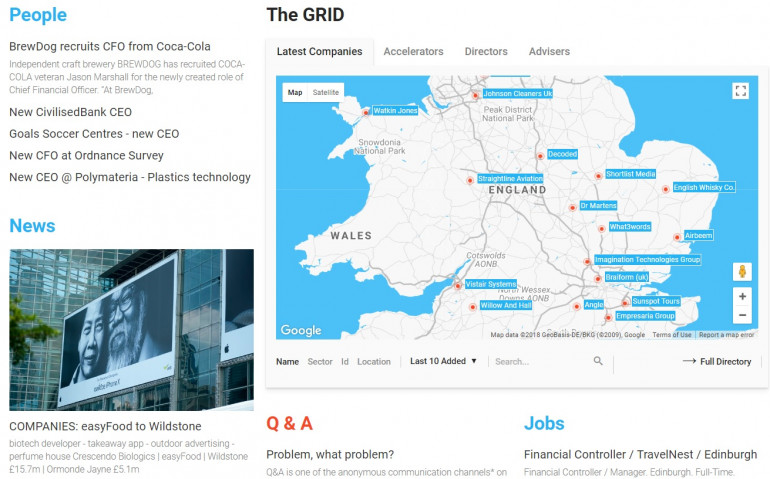Published by Directorzone Markets Ltd on June 1, 2016, 9:00 am in Knowledge, Market Info
Wednesday January 1st 2020

Directorzone
Digest of news and trends in the GRID marketplace in May 2016:
What’s up with exports? | Brexit threat to science research | University research & city cash | Biotech spinout investment | Apprenticeship 0.5% tax | Ant engine nanobots | Green power successes
WHAT’S UP WITH EXPORTS?
Exports really should be everyone’s cup of tea | Kiki Loizou, The Sunday Times. May 29.
A trade report by the British Chambers of Commerce suggested that, while confidence among exporters grew slightly at the start of the year, export figures remain disappointing. In services particularly, a sector that historically has led the way in exports, numbers are in decline. Overall, first-quarter exports were down 4.4% on the same period last year.
Official data shows Britain’s exports for March amounted to £24.9bn, an increase of £700m on the previous month but £3.5bn down on March 2015.
Some … believe the government is simply not doing enough to support companies with ambitions for overseas growth. Moreover, some research suggests that smaller firms are just not interested in selling abroad. The state agency UK Trade & Investment (UKTI) spends more than £250m a year “enhancing the competitiveness of companies through overseas trade” and has a target of exporting goods and services worth £1 trillion by 2020. Experts believe the goal will not be reached unless changes are made and help becomes accessible.
Mike Cherry, chairman of the Federation of Small Businesses, said: “Small firms … need effective and tailored signposting to access support. … confidence among small businesses is at its lowest level since 2013, alongside a worrying decline in export performance with small firms. “Economic uncertainty in the eurozone and weakening demand from China have been big challenges ...”
But … research from the software giant Sage …found that just 4% of firms think a vote for Brexit will have a significant impact on trade within the EU.
BREXIT THREAT TO SCIENCE RESEARCH
UK will be ‘poor cousin’ of European science, Brexit study warns | Andrew Ward, FT. May 19
A report by Digital Science, a research software company warns that quitting the bloc could turn Britain into the “poor cousin” of European science, pointing out that:
A quarter of all public funding for research in the UK comes from the EU, making the country the second-biggest recipient after Germany. Over the past decade, EU research funding to the UK has topped £8.04bn, just behind the £8.34bn allocated to Germany. However, the UK is much more dependent on EU money than Germany because it commits just 1.63 per cent of its own gross domestic product to research, while Germany spends 2.85 per cent.
Almost £1bn in annual research funding would be thrown into doubt if the UK left the EU. The UK received £967m in research grant funding from the EU last year. Since 2009, it has recouped 7.4 per cent of its EU contributions from such funding. In the past decade the EU provided:
41 per cent of public funding for CANCER RESEARCH in the UK, amounting to £126m;
62 per cent, or £13.5m, of public funding for NANOTECHNOLOGY;
More than half of public funding for EVOLUTIONARY BIOLOGY and FORESTRY SCIENCE
…and 94 per cent, or £11m, for ECONOMIC THEORY.
Research-intensive companies also benefit: Rolls-Royce received £51m — almost 13 per cent of its grant-funding — and BT pulled in £23.8m, almost 80 per cent of its total. The BBC, the UK’s public-funded broadcaster, received £2.87m from the EU for research, compared with £4m from domestic sources.
EU funds cover up deficiencies in the way UK science was funded both by government and the corporate sector. … UK businesses benefiting from the fruits of EU-funded research while skimping on their own investment. The private sector contributes the equivalent of 1.06 per cent of GDP towards R&D;, below the EU average and 80 per cent lower than German businesses.
UK universities would be among the biggest victims; Cambridge and Oxford relied on the EU for at least a fifth of the total public funding they get from UK and European research bodies. For smaller institutions it’s as high as two-thirds.
… a vote to leave would not necessarily stop all EU funding. But the report noted that only 7 per cent of research money allocated by the EU and European Research Council in the past decade has gone to non-member states.
Dame Julia Goodfellow, president of Universities UK, told the House of Lords science and technology committee last month that Britain would lose influence as well as funding if it was outside the EU. “Membership of the EU allows UK and European researchers to pool their resources, expertise and data to achieve more together than they could do alone,” she said.
UNIVERSITY RESEARCH & CITY CASH
Hedge funds and universities find mutual benefit from closer ties | Lindsay Fortado, FT. May 14.
Hedge funds are stepping in to fill a funding gap left by government austerity measures at universities that has left them more reliant on donations, tuition fees, and investments.
The money is funding institutes focused on mathematics, data science and finance. While the motivations of the hedge funds varies, it is facilitating closer ties that some of them hope will create opportunities for research and to recruit sought-after holders of maths and physics PhDs. This week:
MAN GROUP’s quantitative trading division AHL launched a centre for machine learning at Oxford University; Man AHL’s relationship with Oxford is about a decade old, when the Oxford-Man Institute of Quantitative Finance was founded with £13.75m from the London-based hedge fund. Its new centre for machine learning, announced this week, is more of a collaboration between business and academia than the others. The firm hopes to incorporate the research ideas produced at the centre — believed to be the first that will focus solely on machine learning in finance — into its trading algorithms. Sandy Rattray, chief executive of AHL: “The main driver is the research. We have much more data than we ever had before and we’d like to find patterns in that data.” Research from the institute has already been used by AHL, he said. Two such areas are galaxy classifications, which they found could be used to classify analyst recommendations, and on the estimation of the height of tides.
A new centre at Cambridge University funded by CANTAB CAPITAL PARTNERS opened. One of AHL’s competitors, Cantab Capital, said its £5m donation to open the Institute for the Mathematics of Information was purely philanthropic. “I personally don’t think the process of outsourcing your research to academia is the right approach,” said Ewan Kirk, Cantab’s chief investment officer. Cantab, based in Cambridge, will have no involvement or input into the work done at the school, but plans to offer internships to the students. The institute opened this week and will take the first six PhD candidates starting in October. “Information is the next frontier in science, and it’s something that we find interesting,” Mr Kirk said. “We produce vast amounts of information, an unthinkable amount. Managing and understanding that data is a really big problem.”
and OMNI PARTNERS, a London-based hedge fund, bought a 50 per cent stake in Banking Science a systematic trading company which emerged from University College London’s Centre for Doctoral Training. The fund, known as BSL, will still be part-owned by two members of UCL’s staff. Peter Coates, chief executive of Omni.
It is not just quants who are giving money. In recent years, hedge funds including Lansdowne and Brevan Howard have also provided millions of pounds to British universities. One of the largest donations, £20.1m, so far has come from Alan Howard, the billionaire founder of the hedge fund BREVAN HOWARD, to create a centre for financial analysis at Imperial College that will research market contagion.
BIOTECH SPINOUT INVESTMENT
Oxford biotech deals highlight stature of UK university spinouts | Andrew Ward, FT. May 11.
A trio of biotech companies based on science from the University of Oxford have raised almost £37m in a record round of fundraising for UK academic spinouts. OxStem, EvOx and Vaccitech all received money from OXFORD SCIENCES INNOVATION, a £300m fund set up last year with backing from several high-profile City investors.
“We are seeing more long-term investment in building scalable businesses which is something the UK has found difficult in the past,” said Adam Stoten, head of technology transfer at ISIS INNOVATION, which is responsible for commercialising intellectual property from Oxford.
Other leading UK universities have also gained access to similar pots of money: the £50m UCL Technology Fund set up in January; the same month, the £40m Apollo Therapeutics Fund was created in collaboration with Cambridge, Imperial College London and UCL. These have joined others such as Imperial Innovations, IP Group and Cambridge Innovation Capital which were already active on UK campuses.
…growing interest from investors, industry and policymakers in unlocking IP from universities and helps the resulting spinout companies clear the “valley of death” in which many fail due to lack of funds.
AstraZeneca, GlaxoSmithKline and Johnson & Johnson, three of the world’s largest pharmaceuticals groups, are among the investors behind the Apollo fund, for example, as they scour academia for the next blockbuster drugs.
The UK has five of the world’s top 10 medical research universities, according to Times Higher Education, and Oxford has been number one for the past five years.
When promising spinouts emerge they often sell out to foreign buyers before reaching their full potential — leaving the UK without any large biotech companies on the scale of US groups such as Amgen, Biogen and Gilead. Examples of squandered potential include Humira, the rheumatoid arthritis drug which had its origins in research by the UK MEDICAL RESEARCH COUNCIL but was commercialised in the US. It is now the world’s best-selling medicine with annual sales for AbbVie of $13bn.
Hopes for the future have been raised by a new generation of young UK life science companies, including Oxford spinouts Immunocore, Adaptimmune and Oxford Nanopore, which have attracted hundreds of millions of dollars of investment over the past two years. But Mr Stoten said it took those companies 10 years to get to that point; he hopes the improving financing landscape will allow OxStem, EvOx and Vaccitech to move faster. “We can grow these businesses more quickly by allowing people to focus on developing products rather than lurching from one fundraising round to the next,” he said.
COMMENTS:
1951jg -- Large Pharma companies, as I predicted many, many years ago, have run out of new products mainly due to the way that R&D; has been funded and managed. As a result many of the better known International ones are struggling to maintain their profit margins. Some have at last recognised that the model needs to change to survive but more importantly, their dependence on these small start ups is rapidly increasing.
Hem Nao! -- This piece of news should be headline on the FT. The success of UK unis at spinouts and funding to public market access is the story of success in Tech UK. Compared to silicon side of tech, it looks to have a much better foundation. One walk around Cambridge, with HQ for AZN and GSK and EU HQ for MSFT among others, the massive construction boom and commensurate vitality in the city, should offer all the evidence of the good things that happen with engineers, risk taking, venture capital access and good science funding.
APPRENTICESHIP 0.5% TAX
A year before its launch, the apprenticeship levy is upsetting owners | Kiki Loizou, The Sunday Times. May 8
Under the apprenticeship levy, due to start next April, companies with a salary bill of more than £3m a year will have to pay a 0.5% payroll tax. The chancellor expects the levy to raise £3bn a year to fund 3m apprenticeships by 2020.
Britain is struggling to improve its skills base. Germany and Australia have more than twice as many apprentices, though there has been progress. Last year 499,900 apprenticeships were taken up in England, compared with 440,400 in 2014-15 — the first rise in two years.
Less than 2% of businesses will have to pay the levy — only those that are big enough to afford it, according to the government. However, it will be a significant burden for thousands of medium-sized ventures and growing companies that are already having to cope with the new national living wage of £7.20 an hour.
Last week the EEF, which represents engineering and manufacturing employers, said only 1% of members surveyed supported the levy. The CBI, the main employers’ organisation, has appealed for ministers to “radically rethink” the new tax. Adam Marshall, acting director-general of the British Chambers of Commerce, said there were reports of companies stopping recruitment to stay below the £3m salary threshold.
Boles, the skills minister, said that the apprenticeship changes were “about putting employers in the driving seat”. He added: “For decades, British industry has underinvested in skills. This is not a time for dither and delay: it needs to boost its investment in skills and the apprenticeship levy will ensure that it does.”
ANT ENGINE NANOBOTS
Scientists build world’s tiniest engine | Clive Cookson, FT. May 3.
Scientists have developed a microscopic engine, the smallest in the world, that they say is the first one capable of driving nanobots, including medical robots that could travel through the body. The prototype device, known as an actuating nano-transducer or Ant, combines microscopic gold balls with a special polymer gel. It generates a propulsive force on a microscopic scale that is a hundred times greater per unit weight than any known motor or muscle.
Professor Jeremy Baumberg, leader of the project at Cambridge university and his team is working with Cambridge Enterprise, the university’s commercialisation arm, to develop practical applications for the technology.
GREEN POWER SUCCESSES
Britain leads charge in renewables | Pilita Clark, FT. May 4
If you had to say which country has the world’s biggest offshore wind farm, Europe’s biggest floating solar park and electricity from the dregs of Fruit Pastilles, you might not guess it was the UK. But over the past five years, with the help of more than £10bn in subsidies, Britain has quietly become a star in the world of green power:
A record 25 per cent of electricity generated last year came from wind farms, solar panels and other renewable power sources, up from 9 per cent in 2011.
For the first time, renewable sources provided more power over the year than coal, the fuel that made the UK the birthplace of the industrial revolution.
The huge London Array wind farm, in the outer Thames estuary, generates more electricity than some coal-fired power stations.
Nestle’s factory in Fawdon, where an anaerobic digestion plant turns leftovers from making sweets such as Fruit Pastilles and Toffee Crisps into biogas that can produce electricity and heat.
Part of a reservoir near Heathrow has been covered in so many solar panels that it has become Europe’s biggest floating solar farm.
The UK recently became the world’s third-largest market for big solar parks after China and the US. Philip Wolfe, a renewables pioneer: “There are now solar PV modules [solar panels] installed on over 800,000 homes and businesses,” he says, as well as the world’s largest offshore wind industry, nearly 30 grid-scale energy storage facilities and several biomass power plants.
The speed at which renewables have grown in the UK last year led the government to start curbing some subsidies, which are largely paid for by levies on consumer energy bills. At least two solar power companies have since gone into administration and some analysts say more could follow in a renewable energy sector that employed more than 112,000 people in 2014.








